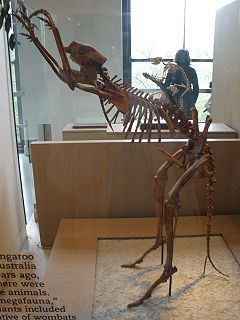Suborder Macropodiformes Higher classification Macropods | Phylum Chordata Scientific name Sthenurinae Rank Subfamily | |
 | ||
Similar | ||
Sthenurinae (from Sthenurus, Latin for 'strong-tailed') is a subfamily within the marsupial family Macropodidae, known as 'short faced kangaroos'. No members of this subfamily remain extant today, with all becoming extinct by the late Pleistocene. Procoptodon goliah, the largest macropodid known to have existed, was a sthenurine kangaroo, however sthenurines come in a range of sizes, with Procoptodon gilli being the smallest at the size of a small wallaby.
The short robust skull of sthenurines is considered to be related to a diet of browse. Some species may have been able to reach above their head and grasp branches with their semiopposable hands to assist in procuring leaves from trees. A single hoofed digit is present on the feet of sthenurines.
Locomotion
Unlike modern macropodids, which hop (either bipedally or quadrupedally), sthenurines seem to have abandoned saltation as a means of locomotion. Their comparatively inflexible spines, robust hindlimb and pelvic elements and the lack of capacity for rapid hopping suggest that these animals walked bipedally, somewhat like hominids, even converging with those primates in details of their pelvic anatomy. Furthermore, their hooved single digits and metatarsal anatomy suggest that, unlike their plantigrade relatives, sthenurines were unguligrade, walking on the tips of their "toes".
